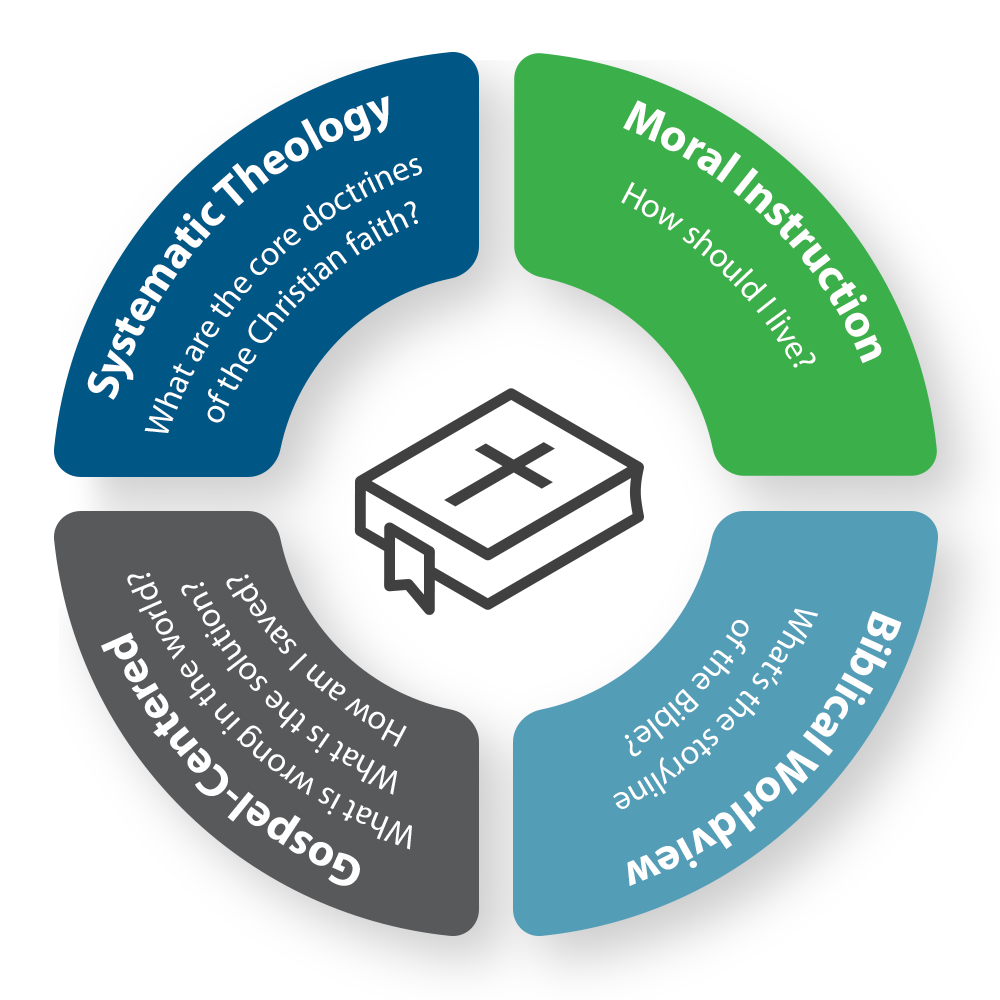
Curriculum
Learn how we can help you disciple children with a curriculum that is God-centered, Bible-saturated, and Gospel-focused.
Our children are constantly bombarded with unbiblical messages from various sources, shaping their young minds in a rapidly changing world. As a church, it’s essential to equip them to pursue truth and embrace a biblical worldview. Our curriculum will help you train children to think and live biblically in a secularized world so that their faith remains strong into adulthood.
What makes RenewaNation’s curriculum distinctive?
Teaches core truths of the Christian faith for lifelong faith in Jesus.
Systematic theology for children.
Helps children develop a biblical worldview.

- The Bible
- The Character of God
- Creation, rebellion, salvation, restoration.
- The person and work of Jesus
- The church
- Salvation
- God’s law
Each lesson includes resources to encourage family discipleship at home, including family devotionals and parent emails, and tools to deepen discipleship in the classroom, such as PowerPoint slides, worksheets, and teaching aids.
Lesson series included in this bundle:
- Who is God?
- The Bible
- Who is Jesus?
- Journey to the Cross
- Big Story
- What is the Church?
- The Ten Commandments
Maximize time spent in biblical instruction.
Introduce children to a great and glorious God.
Train children to rightly interpret and apply the Bible.
Equip children to think critically, spot error, and discern truth claims.
Proclaim the good news of the gospel.
Many curriculums teach Bible stories or a chronology of the Bible that relies heavily on the narrative of Scripture. While it is important to have an understanding of the storyline and narrative of the Bible, children need more than stories, they need sound doctrine and systematic theology to develop a lifelong faith in Jesus. Children need to be taught the core doctrines about God, man, Jesus, the Bible, salvation, church, and more.
Many curriculums do a poor job of connecting the church and home and functionally become the primary source of discipleship for children, despite God giving parents this stewardship. Very few parents ask detailed questions about the curriculum or know what their children are learning at church. Parents need communication about what is taught, the confidence that they can disciple their children, and biblical devotions that accompany the curriculum that provides a doable discipleship path for the home.
It is common for curriculum to fall into one of two categories: say this or play this. The “say this” curriculum provides a speaking script and the teaching time often becomes a dry read aloud. The “play this” curriculum is based on a video that necessitates pushing a button and a classroom manager. Both approaches reveal a low view of the teacher. Our curriculum operates from a “teach this” approach that provides an outline of the main biblical points for teachers to follow, with the freedom to add additional commentary of their own.
There are many different children’s ministry curriculums to choose from, but many of them are Bible-lite, doctrinally-deficient, man-centered, and moralistic. Here are a couple of questions to help you assess the quality of curriculum:
- Are the materials used biblically faithful? Does the curriculum accurately teach passages of Scripture in context? Does the curriculum use a verse as a launch pad into a different topic? Does the curriculum make an object lesson the lesson? Does the curriculum use Bible verses as proof texts or the foundation of the lesson? Are passages correctly interpreted? We want to make sure that children learn the original intent and meaning of the Scripture they are studying.
- What is the focus of the curriculum? Is the focus on God and His story or man and our story? Is the curriculum God-centered or man-centered? Is the curriculum moralistic in nature and present virtues without connection to the Vine? Does the curriculum lift the eye’s of children to Jesus or does it focus their eyes on themselves? Is the Gospel central to everything that is taught? Many children’s curriculums put the focus on us rather than the primary focus on God. Many curriculums are moralistic and miss the gospel.
- Will children gain skills that will transfer into their life? Does it model how to read a passage of Scripture, how to interpret it, and how to apply it to life? Does the curriculum teach children how to rightly handle God’s Word, read it, and memorize it? Are there skills that will transfer beyond the curriculum into the life of a child? Does the curriculum just teach children Bible stories or does it give them skills in how to correctly approach God’s Word? We want to use the time we have with children intentionally.
- Does the curriculum teach children to think biblically? Does the curriculum help children develop a biblical worldview about origins, purpose in life, view of God, the Bible, manhood and womanhood, marriage, the church, the person and work of Jesus, how to live in the world, the problem of sin, and salvation through Christ? Does the curriculum help children to think critically about the views of the world and test ideas according to the Bible? Children will not be faithful to a faith they do not understand and cannot defend.
- How will parents be supported in their God-designed role with their children? Does the curriculum include tools to communicate regularly and effectively with parents? Does the curriculum provide resources to help parents disciple their children at home? What will families sacrifice to participate in this program? Many curriculums unintentionally become the primary means of discipleship for a child so we want to support and encourage parents in their discipleship role.
The preparation time will vary based on the person, familiarity with the curriculum, and the teaching style. In general, 60 to 90 minutes per lesson is normal. A teacher can read the lesson and scan the powerpoint in less than 30 minutes, but to have a command of the Bible passage and teach from an overflow of the heart, it is helpful to spend a little more time than this.
The teaching time can vary between 20-45 minutes depending on how much time you have designated. There are multiple components of each lesson:
- The Bible’s Big Truth and the World’s Big Lie
- Teaching the main points of the lesson
- Optional teaching aids to support the biblical truths of a lesson
- Small group or large group questions to help children understand and apply the lesson
- There is also an optional prayer time and Scripture memory section
It works in either setting. Churches use it in classrooms separated by age, multi-aged settings, or for one large group teaching time.
Increase engagement and deepen discipleship with curriculum tools
Help children grasp biblical truth with powerpoint slides.
Provide meaningful engagement with worksheets and object lessons.
Partner with parents in discipling children.



